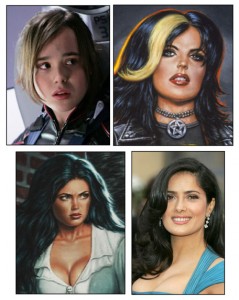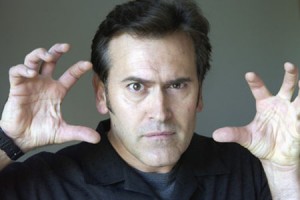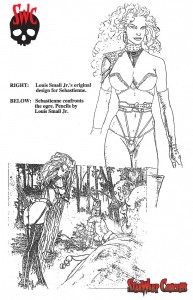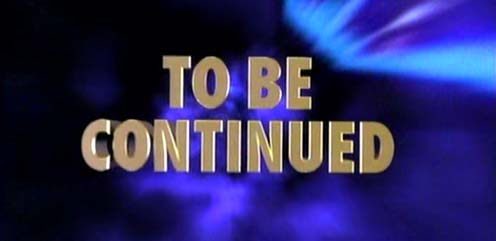Back on August 24th, I introduced you to Pandora Zwieback 1.0: a pregnant teenage runaway who was the main character in a never-completed screenplay titled The Nightlife Ain’t No Good Life. And now the secret origin of Pandora Zwieback continues!
PANDORA ZWIEBACK
An unofficial member of the group, 16-year-old Pandora is Trent’s older sister and the group’s “guardian,” having been appointed as such by the kids’ parents.
Quick-tempered and a touch cynical, Pan resents having to “babysit” a bunch of nerdy kids. What especially annoys her is that Hector obviously has a crush on her, and she’s just not that interested in a “kid” as a boyfriend.
Pan is the member that gives the group their mobility, since she’s the only one old enough to drive a car, which she does with all the hypermobility and instincts of an Indianapolis Raceway driver. This sometimes makes her more of a danger to the kids than whatever threat they happen to be facing.
What you see above is the character description of Pandora Zwieback 2.0—no longer a pregnant teen runaway, but still not a Goth monster hunter; in fact, here she’s not even the lead, but a supporting character!
But what exactly is “here”? Who are Hector and Trent? And what’s with the “bunch of nerdy kids”?
In 1995, I was working as an assistant editor at Byron Preiss Visual Publications, a book-packaging company here in New York. My boss was Howard Zimmerman (who recently edited the first Pan novel, Blood Feud). One day Howard mentioned that a friend of his, Sandy Fritz, an editor at Popular Science Magazine. Seems the company had expressed an interest in publishing a version of the magazine aimed at younger readers, to be called PopSci for Kids.
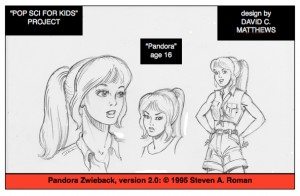 About a week later I presented Sandy with a proposal for The Braintrust: a group of highly intelligent, science-oriented teens and tweens who’d have exciting adventures in each issue of the magazine. (Hector was Pan’s maybe-boyfriend; Trent was her younger brother.) Included were drawings of the characters by David C. Matthews, a small-press artist with whom I’d been working on the original run of my Lorelei comic. As you can see, there are no traces of gothiness in fact, this version of Pan. In fact, she seems to favor Banana Republic over Hot Topic for her outfits!
About a week later I presented Sandy with a proposal for The Braintrust: a group of highly intelligent, science-oriented teens and tweens who’d have exciting adventures in each issue of the magazine. (Hector was Pan’s maybe-boyfriend; Trent was her younger brother.) Included were drawings of the characters by David C. Matthews, a small-press artist with whom I’d been working on the original run of my Lorelei comic. As you can see, there are no traces of gothiness in fact, this version of Pan. In fact, she seems to favor Banana Republic over Hot Topic for her outfits!
Capping off the proposal was the script for the first one-page segment. The story had the kids attending a science fair, where bad guys were in the process of stealing a special computer that was on display. With Pan behind the wheel of the family car, the Braintrust goes into high-speed pursuit—only for one of the bad guys to throw a hand grenade at them!
To be continued!
…or not. Unfortunately, Pop Sci was a little horrified that I’d put the kids in such over-the-top danger, and canceled the project. Throwing grenades at children—really?
Well, hey, you wanted an adventure strip, right? Didn’t anybody over there grow up watching old Johnny Quest cartoons on Saturday mornings?
Oh, well…
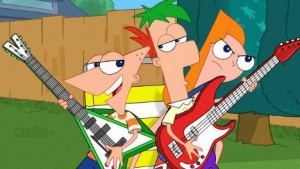 Looking back on the project, and Pan’s role as the grumpy older sister to a smarter younger sibling, I now realize that in 1995 I created the basic idea of Disney’s animated series Phineas and Ferb, with Pan as their older sister, Candace! If only I’d thought to include musical numbers and a secret-agent platypus…
Looking back on the project, and Pan’s role as the grumpy older sister to a smarter younger sibling, I now realize that in 1995 I created the basic idea of Disney’s animated series Phineas and Ferb, with Pan as their older sister, Candace! If only I’d thought to include musical numbers and a secret-agent platypus…

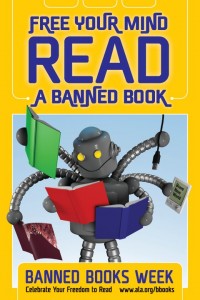

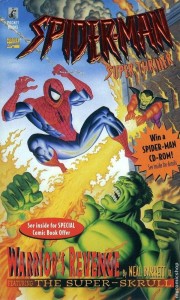 In the late nineties I was an editor for a publisher/book packager named Byron Preiss, who had a license from Marvel Comics to publish original novels based on their characters. Having edited some of the books, and written short stories for a couple of anthologies (Untold Tales of Spider-Man and The Ultimate Hulk), I was offered the chance to take over a YA novel titled Spider-Man Super Thriller: Warrior’s Revenge—Marvel had rejected the manuscript delivered by a mystery and fantasy writer named Neal Barrett Jr. Basically, I was in Byron’s office when news of the rejection came in and he turned to me and said, “So, you want to write it?” Of course I said yes!
In the late nineties I was an editor for a publisher/book packager named Byron Preiss, who had a license from Marvel Comics to publish original novels based on their characters. Having edited some of the books, and written short stories for a couple of anthologies (Untold Tales of Spider-Man and The Ultimate Hulk), I was offered the chance to take over a YA novel titled Spider-Man Super Thriller: Warrior’s Revenge—Marvel had rejected the manuscript delivered by a mystery and fantasy writer named Neal Barrett Jr. Basically, I was in Byron’s office when news of the rejection came in and he turned to me and said, “So, you want to write it?” Of course I said yes!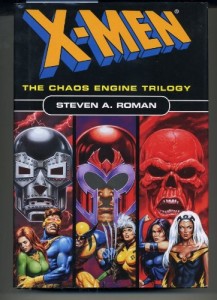 The result was X-Men: The Chaos Engine Trilogy, in which the X-Men fight their archenemy Magneto, Doctor Doom (from the Fantastic Four), and the Red Skull (from Captain America) for control of the Cosmic Cube, a device that allows them to alter reality. All three books sold really well—helped in no small part by the fact that Book 1, X-Men/Dr. Doom, came out in time for the first X-movie. I think that’s when people really started to recognize my byline.
The result was X-Men: The Chaos Engine Trilogy, in which the X-Men fight their archenemy Magneto, Doctor Doom (from the Fantastic Four), and the Red Skull (from Captain America) for control of the Cosmic Cube, a device that allows them to alter reality. All three books sold really well—helped in no small part by the fact that Book 1, X-Men/Dr. Doom, came out in time for the first X-movie. I think that’s when people really started to recognize my byline.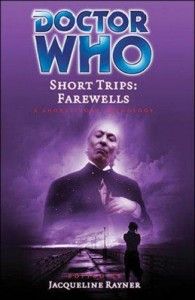 I used to be a major comic book fan, but over the years I got tired with all the superhero stuff—which is kinda funny, considering my professional writing career started with me writing short stories and novels about Spider-Man, the X-Men, and the Incredible Hulk. Now I just spend all my money on Doctor Who merchandise! I’ve been a Who fan—Whovian?—since high school. I even got to write a story for an official Doctor Who anthology!
I used to be a major comic book fan, but over the years I got tired with all the superhero stuff—which is kinda funny, considering my professional writing career started with me writing short stories and novels about Spider-Man, the X-Men, and the Incredible Hulk. Now I just spend all my money on Doctor Who merchandise! I’ve been a Who fan—Whovian?—since high school. I even got to write a story for an official Doctor Who anthology!